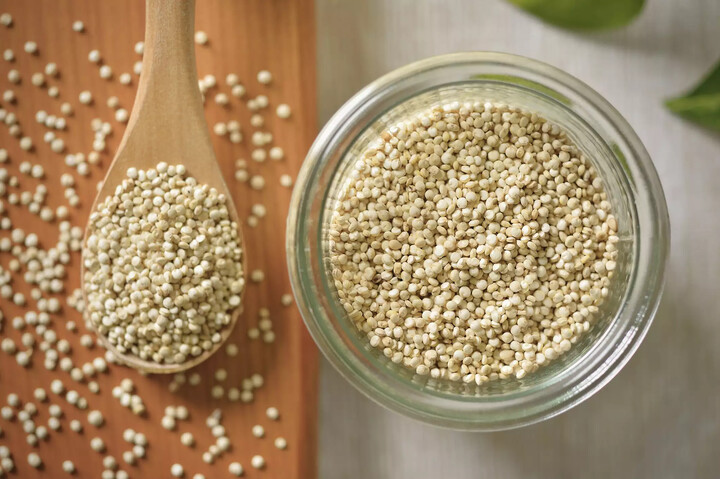Quinoa (Chenopodium quinoa) is a flowering plant in the Amaranth family that is grown as a crop primarily for its edible seeds. It has been grown for human consumption for thousands of years, originating from mountainous regions of South America. Quinoa cultivation has now grown to over 70 countries around the world. This ancient superfood is packed with vitamins and minerals and has a nice mild taste. The seeds are often cooked like rice, or ground into a flour that can be used as a gluten-free alternative in cooking and baking.
Botanical Name:
Chenopodium quinoa
Common Name:
Quinoa
Plant Type:
Herbaceous annual
Mature Size:
4 feet tall
Sun Exposure:
Full sun
Soil Type:
Loamy, well-draining, fertile
Soil pH:
6.0-7.5
Bloom Time:
Summer
Flower Color:
Insignificant, apetalous
Growing Zones:
4+
Native Area:
South America

How to Grow Quinoa Plants
Cool climate gardeners rejoice! Quinoa is the crop for you. Originating from the high altitude slopes of the Andes Mountains, quinoa plants are accustomed to short days, cool temperatures, lots of light, and consistently moist conditions. Unfortunately, due to their size, quinoa plants are unsuitable as container plants; however, they make excellent additions to any existing vegetable or flower garden. Overall, quinoa plants are low-maintenance, easy-to-grow plants.
Light
Quinoa plants grow well in a bright sunny location that receives several hours of direct light a day. However, partial shade from the most intense heat of the day is recommended.
Soil
Quinoa plants grow best in well-drained, loamy soil that is high in organic matter. Before planting, the soil should be amended with compost or fertilizer. Once the seedlings are several inches tall, mulch around the seedlings to prevent weeds and retain moisture.
Water
Quinoa seedlings require consistently moist (but not waterlogged) soil until they are established. Mature quinoa plants are considered relatively drought-tolerant, although they appreciate regular watering. Let the soil dry out slightly and then water thoroughly.
Temperature and Humidity
Quinoa plants are considered to be a cool-climate crop, and they do best when grown in cold, dry climates. High temperatures hinder the growth and seed development of quinoa plants, ultimately affecting the number of seeds that can be harvested.
Ideal temperatures for quinoa plants range between 95 degrees Fahrenheit during the day and 25 degrees Fahrenheit at night. When growing quinoa plants from seed, ensure that the last frost has passed before sowing seeds in the garden as the delicate seedlings cannot tolerate frost.
Fertilizer
Quinoa plants require rich soil that is high in organic matter. Before planting, amend the soil with fresh compost or a balanced organic fertilizer. Beyond this soil preparation, quinoa plants do not require fertilization during the growing period.
Harvesting
Quinoa plants are ready for harvest 90-120 days after planting. Once the leaves have fallen off and only the dried seed heads remain, the seeds are ready to be harvested. Fortunately, quinoa is simple to harvest—the seeds can be stripped upwards towards the stalk which easily dislodges them.
Once harvested, sift the fresh quinoa seeds using a grain sifter. Before storing, the quinoa seeds need to be thoroughly dried out. Spread the seeds out thinly on a tray and place it in the hot sun or near a heat source to dry. Dried quinoa can be stored in an airtight container in a cool, dry location for up to six months.
Growing from Seeds
Quinoa seeds can be sown directly into the garden after the last frost has passed. In climates with warm winters, seeds can even be sown in late summer or early fall for a winter harvest. Soil temperature should be around 60 degrees Fahrenheit for seeds to sprout.
Before planting, prepare the garden bed by gently turning the soil and adding a layer of fresh compost. Space rows of seeds 12 inches apart, and 10-12 inches apart along each row. Plant 2-3 seeds together to ensure that at least one survives in each spot. After the seeds are sowed, cover with a thin layer of soil and spray the top of the soil lightly to moisten.
Quinoa seeds take approximately 4-5 days to germinate. Once seedlings sprout, thin out the rows to ensure there is only one plant every 10-12 inches. Keep seeds and seedlings consistently moist until well-established. Quinoa plants are usually ready for harvest 90-120 days after planting.
Common Pests/Diseases
Fortunately, quinoa seeds are covered in a bitter substance called saponin which protects them from bird and pest damage. However, the leaves of quinoa plants are susceptible to infestations of aphids, flea beetles, leaf miners, and other common pests. Most viruses found in quinoa plants are transmitted by aphids or leafhoppers from other crops in the area, however, the seed production is usually unaffected. Generally, quinoa plants are hardy plants that are susceptible to few serious pests or diseases.